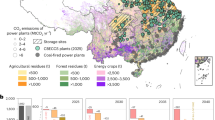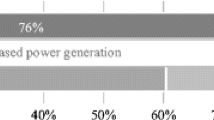Abstract
Among various clean energy technologies, one innovative option for reducing the emission of greenhouse gases (GHGs) and criteria pollutants involves pairing carbon capture and storage (CCS) with the production of synthetic fuels and electricity from a combination of coal and sustainably sourced biomass. With a relatively pure CO2 stream as an inherent byproduct of the process, most of the resulting GHG emissions can be eliminated by simply compressing the CO2 for pipeline transport. Subsequent storage of the CO2 output in underground reservoirs can result in very low—perhaps even near-zero—net GHG emissions, depending on the fraction of biomass as input and its CO2 signature. To examine the potential market penetration and environmental impact of coal-and-biomass-to-liquids-and-electricity (CBtLE), a system-wide sensitivity analysis was performed using the MARKet ALlocation energy model. CBtLE was found to be most competitive in scenarios with a combination of high oil prices, low CCS costs, and, unexpectedly, non-stringent carbon policies. In the scheme considered here (30 % biomass input on an energy basis and 85 % carbon capture), CBtLE fails to achieve significant market share in deep decarbonization scenarios, regardless of oil prices and CCS costs. Such facilities would likely require higher fractions of biomass feedstock and captured CO2 to successfully compete in a carbon-constrained energy system.







Similar content being viewed by others
References
Baliban RC, Elia JA, Floudas CA, Gurau B, Weingarten MB, Klotz SD (2013) Hardwood biomass to gasoline, diesel, and jet fuel: 1. Process synthesis and global optimization of a thermochemical refinery. Energy Fuel 27:4302–4324
Bassano C, Deiana P, Girardi G (2014) Modeling and economic evaluation of the integration of carbon capture and storage technologies into coal to liquids plants. Fuel 116:850–860
Brown KE, Henze DK, Milford JB (2013) Accounting for climate and air quality damages in future U.S. electricity generation scenarios. Environ Sci Technol 47:3065–3072
Cameron C, Yelverton W, Dodder R, West JJ (2014) Strategic responses to CO2 emission reduction targets drive shift in U.S. electric sector water use. Energy Strategy Rev 4:16–27
Fishbone LG, Abilock H (1981) MARKAL: a linear-programming model for energy-systems analysis: technical description of the BNL version. Int Energy Res 5:353–375
Goldemberg J, Guardabassi P (2015) Burden sharing in the implementation of the Climate Convention. Energy Policy 81:56–60
Hamelinck CN, Faaij APC, den Uil H, Boerrigter H (2004) Production of FT transportation fuels from biomass; technical options, process analysis and optimization, and development potential. Energy 29:1743–1771
Herzog H, Smekens K, Dadhich P, Dooley J, Fujii Y, Hohmeyer O, Riahi K, Akai M, Hendricks C, Lackner K, Rana A, Rubin E, Schrattenholzer L, Senior B (2005) Cost and economic potential. In: Metz B, Davidson O, de Coninck H, Loos M, Meyer L (eds) IPCC special report on carbon dioxide capture and storage. Cambridge University Press, New York
Howell FM, Porter JR, Mason PB, Blanchard TC (2010) Spatial contours of potential biomass crop production: an examination of variations by U.S. region. J Rural Soc Sci 25:1–32
IPCC (2014) Climate Change 2014: synthesis report. In: Pachauri RK, Meyer L (eds) Fifth assessment report of the Intergovernmental Panel on Climate Change. Cambridge University Press, Cambridge
Jaramillo P, Griffin WM, Matthews HS (2008) Comparative analysis of the production costs and life-cycle GHG emissions of FT liquid fuels from coal and natural gas. Environ Sci Technol 42:7559–7565
King CW, Webber ME (2008) Water intensity of transportation. Environ Sci Technol 42:7866–7872
Knoope MMJ, Meerman JC, Ramírez A, Faaij APC (2013) Future technological and economic performance of IGCC and FT production facilities with and without CO2 capture: combining component based learning curve and bottom–up analysis. Int J Greenh Gas Control 16:287–310
Larson ED, Fiorese G, Liu G, Williams RH, Kreutz TG, Consonni S (2010) Co-production of decarbonized synfuels and electricity from coal + biomass with CO2 capture and storage: an Illinois case study. Energy Environ Sci 3:28–42
Lenox C, Dodder R, Gage C, Kaplan O, Loughlin D, Yelverton W (2013) EPA U.S. nine-region MARKAL database: database documentation (EPA/600/B-13/203). National Technical Information Service, Washington, DC
Liu G, Larson ED, Williams RH, Kreutz TG, Guo X (2011) Making Fischer–Tropsch fuels and electricity from coal and biomass: performance and cost analysis. Energy Fuel 25:415–437
Liu G, Larson ED, Williams RH, Guo X (2015a) Gasoline from coal and/or biomass with CO2 capture and storage: 1. Process designs and performance analysis. Energy Fuel 29(3):1830–1844
Liu G, Larson ED, Williams RH, Guo X (2015b) Gasoline from coal and/or biomass with CO2 capture and storage: 2. Economic analysis and strategic context. Energ Fuel 29(3):1845–1859
Loughlin DH (2013) Exploring how technology growth limits impact optimal carbon dioxide mitigation pathways. In: Jawahir IS, Sikdar SK, Huang Y (eds) Treatise on sustainability science and engineering. Springer, New York, pp 175–190
Loughlin DH, Benjey WG, Nolte CG (2011) ESP v1.0: methodology for exploring emission impacts of future scenarios in the United States. Geosci Model Dev 4:287–297
Loughlin DH, Yelverton WH, Dodder RS, Miller CA (2012) Methodology for examining potential technology breakthroughs for mitigating CO2 and application to centralized solar photovoltaics. Clean Technol Environ Policy 15:9–20
Loulou R, Goldstein G, Noble K (2004) Documentation for the MARKAL family of models. Energy Technology Systems Analysis Programme, Paris, France. http://www.etsap.org/MrklDoc-I_StdMARKAL.pdf. Accessed 13 Feb 2015
Lu X, Norbeck JM, Park CS (2012) Production of Fischer–Tropsch fuels and electricity from bituminous coal based on steam hydrogasification. Energy 48:525–531
Mantripragada HC, Rubin ES (2011) Techno-economic evaluation of coal-to-liquids (CTL) plants with carbon capture and sequestration. Energy Policy 39:2808–2816
Mantripragada HC, Rubin ES (2013) CO2 implications of coal-to-liquids (CTL) plants. Int J Greenh Gas Control 16:50–60
Meerman JC, Ramirez A, Turkenburg WC, Faaij APC (2011) Performance of simulated flexible integrated gasification polygeneration facilities. Part A: a technical-energetic assessment. Renew Sustain Energy Rev 15:2563–2587
Meerman JC, Ramírez A, Turkenburg WC, Faaij APC (2012) Performance of simulated flexible integrated gasification polygeneration facilities. Part B: economic evaluation. Renew Sustain Energy Rev 16:6083–6102
Meerman JC, Knoope MMJ, Ramírez A, Turkenburg WC, Faaij APC (2013) Technical and economic prospects of coal- and biomass-fired integrated gasification facilities equipped with CCS over time. Int J Greenh Gas Control 16:311–323
NETL (2015a) Fischer–Tropsch synthesis. National Energy Technology Laboratory, Pittsburgh. http://www.netl.doe.gov/research/coal/energy-systems/gasification/gasifipedia/sasol. Accessed 12 May 2015
NETL (2015b) Coal and biomass to liquids: major test partners. National Energy Technology Laboratory, Pittsburgh. http://www.netl.doe.gov/research/coal/energy-systems/fuels/coal-and-biomass-to-liquids/major-test-partners. Accessed 12 May 2015
NETL (National Energy Technology Laboratory) (2009) Affordable, low-carbon diesel fuel from domestic coal and biomass. U.S. Department of Energy Report DOE/NETL-2009/1349. U.S. Department of Energy, Pittsburgh
Noureldin MMB, Bao B, Elbashir NO, El-Halwagi MM (2014) Benchmarking, insights, and potential for improvement of Fischer–Tropsch-based biomass-to-liquid technology. Clean Technol Environ Policy 16:37–44
Rudokas J, Miller PJ, Trail MA, Russell AG (2015) Regional air quality management aspects of climate change: impact of climate mitigation options on regional air emissions. Environ Sci Technol 49:5170–5177
Sadeghinezhad E, Kazi SN, Sadeghinejad F, Badarudin A, Mahrali M, Sadri R, Safaei MR (2014) A comprehensive literature review of bio-fuel performance in internal combustion engine and relevant costs involvement. Renew Sustain Energy Rev 30:29–44
Sarica K, Tyner WE (2012) Analysis of US renewable fuels policies using a modified MARKAL model. Renew Energy 50:701–709
Swanson RM, Platon A, Satrio JA, Brown RC (2010) Techno-economic analysis of biomass-to-liquids production based on gasification. Fuel 89:S11–S19
Tchapda AH, Pisupati SV (2014) A review of thermal co-conversion of coal and biomass/waste. Energies 7:1098–1148
Tijmensen MJA, Faaij APC, Hamelinck CN, van Hardeveld MRM (2002) Exploration of the possibilities for production of Fischer Tropsch liquids and power via biomass gasification. Biomass Bioenergy 23:129–152
Tock L, Gassner M, Maréchal F (2010) Thermochemical production of liquid fuels from biomass: thermo-economic modeling, process design and process integration analysis. Biomass Bioenergy 34:1838–1854
US DOE (2015a) xTL fuels. US Department of Energy, Office of Energy Efficiency and Renewable Energy, Washington, DC. http://www.afdc.energy.gov/fuels/emerging_xtl_fuels.html. Accessed 12 May 2015
US DOE (2015b) Cushing, OK WTI spot price FOB. US Department of Energy, Energy Information Administration, Washington, DC. http://www.eia.gov/dnav/pet/hist/LeafHandler.ashx?n=pet&s=rwtc&f=d. Accessed 13 April 2015
US DOE (2015c) Coal data browser. US Department of Energy, Energy Information Administration, Washington, DC. http://www.eia.gov/beta/coal/data/browser/. Accessed 13 April 2015
US DOE (2013) Electric power annual 2012. US Department of Energy, Energy Information Administration, Washington, DC
US DOE (2014) Annual energy outlook 2014 with projections to 2040. DOE/EIA-0383(2014). US Department of Energy, Energy Information Administration, Washington, DC
Xie X, Wang M, Han J (2011) Assessment of fuel-cycle energy use and greenhouse gas emissions for Fischer–Tropsch diesel from coal and cellulosic biomass. Environ Sci Technol 45:3047–3053
Zhou W, Zhu B, Chen D, Zhao F, Fei W (2011) Technoeconomic assessment of China’s indirect coal liquefaction projects with different CO2 capture alternatives. Energy 36:6559–6566
Acknowledgments
The authors wish to express their sincere gratitude to the members of the Energy and Climate Assessment Team (ECAT) of the U.S. Environmental Protection Agency’s Office of Research and Development, including Carol Lenox and Ozge Kaplan, who are responsible for maintaining and distributing EPA’s MARKAL databases. Many thanks also to Bela Deshpande, now of the California Air Resources Board, whose initial research on CBtLE as a research fellow at EPA helped provide a basis for the study presented here. This project was supported in part by an appointment to the Postdoctoral Research Program at the Office of Research and Development, U.S. Environmental Protection Agency, administered by the Oak Ridge Institute for Science and Education through an interagency agreement between the U.S. Department of Energy and EPA.
Author information
Authors and Affiliations
Corresponding author
Ethics declarations
Disclaimer
This article has been subjected to the agency’s peer and administrative review and has been cleared for publication. The views expressed in this article are those of the authors and do not necessarily reflect the views or policies of the U.S. Environmental Protection Agency.
Rights and permissions
About this article
Cite this article
Aitken, M.L., Loughlin, D.H., Dodder, R.S. et al. Economic and environmental evaluation of coal-and-biomass-to-liquids-and-electricity plants equipped with carbon capture and storage. Clean Techn Environ Policy 18, 573–581 (2016). https://doi.org/10.1007/s10098-015-1020-z
Received:
Accepted:
Published:
Issue Date:
DOI: https://doi.org/10.1007/s10098-015-1020-z




